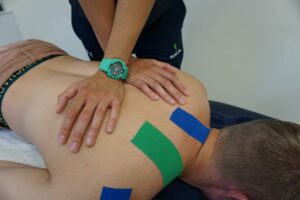Wat zijn ademhalingstechnieken?
Ademhalingstechnieken zijn verschillende manieren van ademhalen die we kunnen uitvoeren. Sommige ademhalingstechnieken kun je jezelf aanleren en sommige technieken voeren we automatisch al uit. Omdat ademen zo vanzelfsprekend is staan we er vaak niet bij stil dat er verschillende technieken zijn waarop we adem kunnen halen.
Ook staan we er niet automatisch bij stil dat de manier waarop je ademt, veel effect kan hebben op je gezondheid en zelfs een mogelijke oorzaak kan zijn van verschillende lichamelijke kwaaltjes of zelfs ernstigere kwalen en aandoeningen. Daarnaast geeft het type ademhalingstechniek dat je (onbewust) hanteert informatie over hoe wel of niet ontspannen je lichaam is. Dit alles bij elkaar geeft genoeg reden om je eigen ademhalingspatroon eens goed onder de loep te nemen.
Wat is het doel van ademhalingstechnieken en waarom is een goede ademhaling zo belangrijk?
Het hoofddoel van ademhalingstechnieken is een goede ventilatie van de longen waardoor de gaswisseling verbetert en de ademhaling efficiënter gebeurt. Daarnaast wordt met ademhalingstechniek invloed uitgeoefend op de ademfrequentie en ademdiepte. Ademhalingstechnieken worden ook ingezet om lucht achter de slijmprop in de longen te krijgen en om deze daardoor gemakkelijker op te hoesten.
Een goede ademhaling is belangrijk voor je lichamelijke en mentale gezondheid. Met een goede ademhaling krijgen je hersenen en spieren genoeg zuurstof. Dit zorgt er bijvoorbeeld voor dat je kunt bewegen of je kunt concentreren op een bepaalde taak.
Ook kun je met een goede ademhaling je stressklachten verminderen. Als je goed ademt, wordt je hartslag lager, heb je minder spanning in je spieren en voel je meer rust. Het lukt je beter om te ontspannen.
Wat zijn de 5 meest bekende ademhalingstechnieken?
1. Diafragmatische ademhaling (Buikademhaling):
Hierbij adem je diep in, waarbij je je buik uitzet door het laten zakken van het middenrif. Het bevordert een diepere en meer ontspannen ademhaling.
2. 4-7-8 ademhalingstechniek:
Ontwikkeld door Dr. Andrew Weil, omvat deze techniek inademen gedurende 4 tellen, de adem inhouden gedurende 7 tellen en vervolgens langzaam uitademen gedurende 8 tellen. Het wordt vaak gebruikt voor ontspanning en stressvermindering.
3. Nadi Shodhana (Wisselende neusgatademhaling):
Een yogische ademhalingstechniek waarbij je afwisselend door elk neusgat inademt en uitademt. Het bevordert balans, concentratie en ontspanning.
4. Pursed-lip ademhaling:
Bij deze techniek adem je langzaam in door de neus en adem je vervolgens uit door licht geperste lippen. Het helpt de luchtwegen open te houden en wordt vaak gebruikt bij longproblemen.
5. Mindful ademhaling:
Hierbij concentreer je je op het bewust waarnemen van je ademhaling, zonder deze te veranderen. Het is een onderdeel van mindfulness en kan helpen bij stressvermindering en het bevorderen van bewustzijn.
De Wim Hof ademhaling methode:
De Wim Hof ademhaling is een speciale ademhalingstechniek die het zuurstofniveau verhoogt. Dit heeft ontzettend veel positieve effecten. Omdat ademen automatisch gebeurt staan we er misschien niet zo bewust bij stil. Echter zijn er heel veel voordelen te behalen met het bewust reguleren van je ademhaling.
Met de Wim Hof ademhaling focus je een zogenaamde krachtademhaling. Hiervoor worden specifieke ademhalingsoefeningen toegepast. De oefeningen zijn gefocust op diepe en ritmische in- en uitademingen. De ademhalingstechniek zorgt ervoor dat er energie vrijkomt. Daarnaast werkt de techniek in op het autonome zenuwstelsel.
Het ritme van de Wim Hof ademhaling triggert bewust een zekere stress of hyperventilatie reactie. Dit zorgt ervoor dat er adrenaline in het lichaam wordt aangemaakt. Op dat moment is het de bedoeling om tijdelijk de adem in te houden en zo je lichaam te trainen om kalm te blijven. Je kunt je voorstellen dat als je in een situatie zit waarbij adrenaline vrijkomt dit meestal een setting is waarin we bijvoorbeeld stress, angst of zenuwen ervaren. Door hier met deze techniek bewust op in te spelen zorgt dit ervoor dat je in staat bent om naar een staat van volledige ontspanning te switchen, het maakt je veerkrachtiger en weerbaarder voor stress.
Dit hoogtepunt van de ademhaling vasthouden tijdens de oefening wordt binnen de Wim Hof Methode ook wel retentie genoemd. De ademhaling kan voor wel 3 minuten vastgehouden worden.
De Wim Hof ademhaling is onderdeel van de Wim Hof Methode die uit 3 pijlers bestaat:- Ademen
- kou therapie
- mindset
Deze drie onderdelen samen kunnen bijdragen aan het ontwikkelen van een sterker lichaam, mentaal en fysiek.
Neusademhaling voor betere sportprestaties:
Neusademhaling is misschien een ongebruikelijke techniek voor veel atleten, maar het is de manier waarop ons lichaam bedoeld is om te ademen. De neus is een complex en verfijnd orgaan dat meer doet dan alleen lucht transporteren. Het filtert, verwarmt en bevochtigt de lucht, waardoor de longen efficiënter werken. Neusademhaling leidt ook tot een verhoogde CO2-retentie, wat leidt tot diverse voordelen zoals het Bohr-effect, waarbij meer zuurstof naar de spieren wordt getransporteerd.
1. Minder Spierpijn:
Neusademhaling verbetert de zuurstoftoevoer naar de spieren, mede door het Bohr-effect. Dit effect beschrijft hoe een hogere CO2-concentratie in het bloed de zuurstofafgifte aan de spieren bevordert. Door de neus te ademen, blijft er meer CO2 in het lichaam, wat helpt bij het afgeven van zuurstof waar het nodig is. Bovendien zorgt de verhoogde aanwezigheid van stikstofoxide bij neusademhaling voor een betere doorbloeding. Samen kunnen deze factoren de afvoer van afvalstoffen versnellen en spierpijn verminderen.
2. Minder Kans op Blessures:
Neusademhaling betrekt het middenrif effectiever, wat bijdraagt aan een betere lichaamshouding en balans. Dit verlaagt het risico op overbelastingsblessures door een betere alignering van de wervelkolom en de rest van het lichaam. Bovendien zorgt de betere doorbloeding van de spieren voor een efficiëntere voedingsstoflevering, waardoor het risico op blessures verder afneemt.
3. Betere Prestatie:
Neusademhaling helpt bij het verhogen van de CO2-tolerantie in de bloedbaan, wat betekent dat je lichaam efficiënter omgaat met zuurstof. Dit kan leiden tot betere aerobe prestaties en uithoudingsvermogen, waardoor je harder en langer kunt trainen.
4. Sneller Herstellen:
Neusademhaling bevordert het parasympathische zenuwstelsel, wat helpt bij ontspanning en herstel na de inspanning. Het kan ook de slaapkwaliteit verbeteren, een cruciale factor in het herstelproces, waardoor je frisser en energieker aan de volgende training kunt beginnen. Daarnaast zorg ook hier de stikstofmonoxide voor verbeterde zuurstofafgifte en opname.
5. Minder Vochtverlies:
Ademen via de neus kan het vochtverlies verminderen, aangezien de neus de ingeademde lucht bevochtigt en verwarmt. Dit kan dehydratie helpen voorkomen, vooral tijdens lange en intensieve trainingen.
Wat doet een ademcoach precies?
Je kunt ademwerk of breathwork zien als een verzamelnaam voor verschillende ademhalingstechnieken. Er zijn korte ademhalingsoefeningen die je gedurende de dag kunt doen om je concentratie te verscherpen, je pijn te verzachten, nieuwe energie op te doen of stress los te laten. Maar je kunt breathwork ook therapeutisch en transformatief inzetten.
Aangezien er veel verschillende vormen van ademwerk zijn, zijn er ook veel verschillende soorten ademcoaches.
Over het algemeen ga je naar een ademcoach om meer bewustzijn te krijgen van jouw ademhaling in relatie tot jouw lichaam en geest en te leren hoe je je ademhaling kunt sturen zodat je je beter kunt voelen. En zodat je ook beter leert voelen in het algemeen, iets wat veel mensen verleerd zijn.
Je hebt dus ademcoaches waar je heen gaat om praktische oefeningen aan te leren voor meer ontspanning en zelfheling, je hebt ook ademcoaches die jou meenemen in een diepgaande ademsessie waarbij de adem wordt ingezet als tool om je te bevrijden van vastgezette emoties en trauma. En dan is er nog van alles tussenin.
Wat zijn voorkomende klachten bij een verkeerde ademhaling?
Verkeerd ademen kan leiden tot bepaalde klachten. Hieronder een aantal veel voorkomende klachten bij een verkeerde ademhaling
– Een benauwd gevoel
– Duizeligheid
– Een licht gevoel in je hoofd
– Je voelt je hart sneller kloppen
– Tintelingen rond de mond en in de handen
– Een drukkend gevoel of steken op de borst
– Kramp in de spieren







